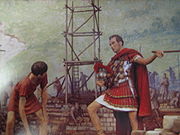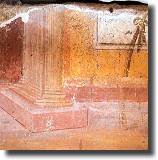
Dubris
Encyclopedia

Roman Britain
Roman Britain was the part of the island of Great Britain controlled by the Roman Empire from AD 43 until ca. AD 410.The Romans referred to the imperial province as Britannia, which eventually comprised all of the island of Great Britain south of the fluid frontier with Caledonia...
. It is now Dover
Dover
Dover is a town and major ferry port in the home county of Kent, in South East England. It faces France across the narrowest part of the English Channel, and lies south-east of Canterbury; east of Kent's administrative capital Maidstone; and north-east along the coastline from Dungeness and Hastings...
, Kent
Kent
Kent is a county in southeast England, and is one of the home counties. It borders East Sussex, Surrey and Greater London and has a defined boundary with Essex in the middle of the Thames Estuary. The ceremonial county boundaries of Kent include the shire county of Kent and the unitary borough of...
, England.
As the closest point to continental Europe
Continental Europe
Continental Europe, also referred to as mainland Europe or simply the Continent, is the continent of Europe, explicitly excluding European islands....
and the site of the estuary
Estuary
An estuary is a partly enclosed coastal body of water with one or more rivers or streams flowing into it, and with a free connection to the open sea....
of the Dour
River Dour, Kent
The River Dour is a river in the county of Kent, in England. It flows from the villages of Temple Ewell and River, through the village of Kearsney, to Dover. It is roughly 4km long....
, the site chosen for Dover was ideal for a cross-channel port. (The Dour is now covered over for much of its course through the town.) In the Roman era, it grew into an important military, mercantile and cross-channel harbour and - with Rutupiae
Rutupiae
Richborough Castle contains the ruined remains of a Roman Saxon Shore Fort. It situated in Richborough near Sandwich, Kent.The site has many phases of Roman remains, collectively known as Richborough Fort or Richborough Roman Fort, still visible today and under the care of English Heritage.Rutupiæ ...
- one of the two starting points of the road later known as Watling Street
Watling Street
Watling Street is the name given to an ancient trackway in England and Wales that was first used by the Britons mainly between the modern cities of Canterbury and St Albans. The Romans later paved the route, part of which is identified on the Antonine Itinerary as Iter III: "Item a Londinio ad...
. It was fortified and garrisoned initially by the Classis Britannica, and later by troops based in a Saxon Shore Fort.
Caesar
Britons on the cliffs at Dover forced Caesar to land further north, at WalmerWalmer
Walmer is a town in the district of Dover, Kent in England: located on the coast, the parish of Walmer is six miles north-east of Dover. Largely residential, its coastline and castle attract many visitors...
.
Classis Britannica fort
The Roman fleet in British waters, the Classis Britannicas main purpose was protecting the Gaul-to-Britain routes and supporting the land army in BritanniaBritannia
Britannia is an ancient term for Great Britain, and also a female personification of the island. The name is Latin, and derives from the Greek form Prettanike or Brettaniai, which originally designated a collection of islands with individual names, including Albion or Great Britain. However, by the...
, not defending the British Isles from invasion. For this reason its main fort was in Portus Itius (Boulogne-sur-Mer
Boulogne-sur-Mer
-Road:* Metropolitan bus services are operated by the TCRB* Coach services to Calais and Dunkerque* A16 motorway-Rail:* The main railway station is Gare de Boulogne-Ville and located in the south of the city....
, called also Gesoriacum or Bononia), not Dover. However, it did have other, smaller bases in Britannia itself, at Rutupiae
Rutupiae
Richborough Castle contains the ruined remains of a Roman Saxon Shore Fort. It situated in Richborough near Sandwich, Kent.The site has many phases of Roman remains, collectively known as Richborough Fort or Richborough Roman Fort, still visible today and under the care of English Heritage.Rutupiæ ...
and Dubris.

Lighthouses
Two lighthouseLighthouse
A lighthouse is a tower, building, or other type of structure designed to emit light from a system of lamps and lenses or, in older times, from a fire, and used as an aid to navigation for maritime pilots at sea or on inland waterways....
s, each called the Pharos, were built soon after the conquest. Proposals of their date range from 50 (only seven years after the invasion of 43), 80 or (since the building includes tiles identical to the mansio in the town built at that date) c.138, though the general consensus is for a 1st century AD date. They were sited on the two heights (Eastern Heights and Western Heights
Dover Western Heights
The Western Heights of Dover are one of the most impressive fortifications in Britain. They comprise a series of forts, strong points and ditches, designed to protect the country from invasion...
) and modelled on the one built for Caligula
Caligula
Caligula , also known as Gaius, was Roman Emperor from 37 AD to 41 AD. Caligula was a member of the house of rulers conventionally known as the Julio-Claudian dynasty. Caligula's father Germanicus, the nephew and adopted son of Emperor Tiberius, was a very successful general and one of Rome's most...
's aborted invasion at Boulogne.
The one on the Eastern Heights still stands in the grounds of Dover Castle
Dover Castle
Dover Castle is a medieval castle in the town of the same name in the English county of Kent. It was founded in the 12th century and has been described as the "Key to England" due to its defensive significance throughout history...
to 80 feet (24 m) high close to its original height, and has been adapted for use as the bell tower
Bell tower
A bell tower is a tower which contains one or more bells, or which is designed to hold bells, even if it has none. In the European tradition, such a tower most commonly serves as part of a church and contains church bells. When attached to a city hall or other civic building, especially in...
of the adjacent castle church of St Mary de Castro
St Mary de Castro (Dover)
St Mary in Castro, or St Mary de Castro, is a church in the grounds of Dover Castle, Kent, south-east England. It is a heavily restored Saxon structure, built next to a Roman lighthouse which became the church bell-tower...
. What little remains of the western lighthouse is called the Bredenstone or the Devil's Drop of Mortar after the putative nearby lost village of Braddon, within Drop Redoubt on Dover Western Heights
Dover Western Heights
The Western Heights of Dover are one of the most impressive fortifications in Britain. They comprise a series of forts, strong points and ditches, designed to protect the country from invasion...
- it was covered in the 18th century building works but then rediscovered in fresh works in the 1860s, and was the traditional site of the investiture of the Lord Warden of the Cinque Ports
Lord Warden of the Cinque Ports
The Lord Warden of the Cinque Ports is a ceremonial official in the United Kingdom. The post dates from at least the 12th century but may be older. The Lord Warden of the Cinque Ports was originally in charge of the Cinque Ports, a group of five port towns on the southeast coast of England...
.http://www.dover.gov.uk/museum/focus/focus9.asp
Peak
At its peak, Dubris was a major trading centre, taking over from Rutupiae as the main Roman cross-Channel port. With Rutupiae, it was one of the starting points for Watling StreetWatling Street
Watling Street is the name given to an ancient trackway in England and Wales that was first used by the Britons mainly between the modern cities of Canterbury and St Albans. The Romans later paved the route, part of which is identified on the Antonine Itinerary as Iter III: "Item a Londinio ad...
, the Roman road to Canterbury
Durovernum Cantiacorum
Durovernum Cantiacorum was a town in the Roman province of Britannia. Today it is known as Canterbury, located in the English county of Kent. It occupied a strategic location on Watling Street, at the convergence of the roads coming from the rest of the Roman Empire via the ports of Dubris ,...
and, ultimately, London
History of London
London, the capital of the United Kingdom , has a recorded history that goes back over 2,000 years. During this time, it has grown to become one of the most significant financial and cultural capitals of the world. It has experienced plague, devastating fire, civil war, aerial bombardment and...
.
Roman Painted House
The Roman Painted House is a RomanRoman Empire
The Roman Empire was the post-Republican period of the ancient Roman civilization, characterised by an autocratic form of government and large territorial holdings in Europe and around the Mediterranean....
mansio
Mansio
In the Roman Empire, a mansio was an official stopping place on a Roman road, or via, maintained by the central government for the use of officials and those on official business whilst travelling.-Background:The roads which traversed the Ancient World, were later surveyed,...
, a hostel for government officials, which was built in c. 200. It was discovered in 1970 by the Kent Archaeological Rescue Unit and, as it houses some of the finest example of Roman murals in Britain (over 400 sq ft (37.2 m²). of painted plaster, the most extensive ever found north of the Alps), it has been called "Britain's Buried Pompeii
Pompeii
The city of Pompeii is a partially buried Roman town-city near modern Naples in the Italian region of Campania, in the territory of the comune of Pompei. Along with Herculaneum, Pompeii was destroyed and completely buried during a long catastrophic eruption of the volcano Mount Vesuvius spanning...
".


Mansio
In the Roman Empire, a mansio was an official stopping place on a Roman road, or via, maintained by the central government for the use of officials and those on official business whilst travelling.-Background:The roads which traversed the Ancient World, were later surveyed,...
.
Other features of the Painted House include the Dover Gems, a medieval cut in the floor allowing the hypocaust
Hypocaust
A hypocaust was an ancient Roman system of underfloor heating, used to heat houses with hot air. The word derives from the Ancient Greek hypo meaning "under" and caust-, meaning "burnt"...
system to be viewed and a medieval skeleton found in the nearby St Martin-le-Grand church, nicknamed "Fred" by the volunteers who keep the museum running.
Saxon Shore Fort
Dubris's mansio was demolished in 270 for the construction of a Saxon Shore Fort. This demolition preserved the mansio and its wall-paintings better than usual, since the foots of the walls were contained in the fort's rampartDefensive wall
A defensive wall is a fortification used to protect a city or settlement from potential aggressors. In ancient to modern times, they were used to enclose settlements...
.
Visible remains
A small amount of the fort remains is now visible (on request) at Dover Library and Discovery Centre (the former White Cliffs Experience), and a public housePublic house
A public house, informally known as a pub, is a drinking establishment fundamental to the culture of Britain, Ireland, Australia and New Zealand. There are approximately 53,500 public houses in the United Kingdom. This number has been declining every year, so that nearly half of the smaller...
off Market Square is built on and named after the Roman Quay.
The most extensive and publicly accessible remains are at the Roman Painted House, where parts of the mansio, Saxon Shore Fort and Classis Britannica fort are all visible.
1980s excavations
The story of the 1980s excavations of Roman Dover during the construction of the new A256A256 road
The A256 is a key road running north-south through East Kent which connects the Thanet towns to Dover.- Thanet :The road begins in the outskirts of the Thanet town of Broadstairs, at a roundabout with the A255 where it heads westwards through the Westwood Retail Parks via "Westwood Road".The A256...
/York Street bypass is most interesting. The town council had plans to build a car park on the site, when the KARU team, led by Brian Philp, began to find Roman remains. After a convoluted battle with the council and the builders, the excavation was allowed to continue and a cover-building was built on the site by KARU while the carpark was built elsewhere, with the museum being completed before the car park!
It has since received thousands of visitors, including the Queen Mother
Queen mother
Queen Mother is a title or position reserved for a widowed queen consort whose son or daughter from that marriage is the reigning monarch. The term has been used in English since at least 1577...
, who signed a specially-presented guestbook. Brian Philp continues to curate, giving talks to schoolchildren, tourists and academics alike. Other artefacts including an extremely important glass vessel are kept on the site, attracting academic study in recent years.
This cover-building still stands over these remains. It has changed little since then and is now under threat from lack of funding. Many in the local area have commented that the site would have been better presented had it been integrated with the rest of the site, which was instead largely reburied under the new bypass (which was nevertheless specially inclined to protect these unique remains) and White Cliffs Experience.
All this has been widely criticised by, among others, Brian Philp himself, who has said:
- "Countries that destroy their past deserve no future".

